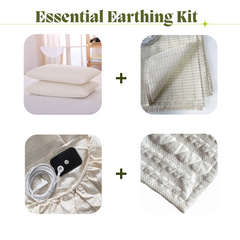Grounding mat, products that work as a concept as ancient as the Earth beneath our feet and promote barefoot connectivity for wound healing, have found their way into modern wellness practices.
Initially rooted in earthing—connecting physically, often barefoot, to the Earth's energy for health benefits through an electrical connection to the ground—these mats offer a portable solution, acting as a sheet.
However, even the most ardent users sometimes need to pay more attention to proper storage, which is crucial for maintaining their efficacy and longevity.
Knowing where to store your grounding mat when not in use ensures it remains an effective tool for neutralizing electrical charges on your body, contributing to your overall well-being and healing. These products work best when used barefoot.
Key Takeaways
- Cool, Dry Place: Store the grounding mat in a cool, dry location to prevent damage from moisture and heat.
- Avoid Sunlight: Keep the mat away from direct sunlight to protect the conductive materials.
- Proper Folding: Fold the mat carefully without sharp creases to maintain its integrity.
Why Proper Storage is Crucial for Maintaining Your Grounding Mat?
Proper storage of your grounding mat products, especially when not in use, can significantly extend their lifespan for ultimate longevity and maintain their effectiveness to guarantee their work.
Grounding mat for bed, products rooted in research, are designed to connect you with the Earth's electrical energy, promoting wellness and supporting health while simulating a barefoot experience. However, like any other wellness tool, they require care to function optimally.
Storing your mat in a cool, dry place prevents moisture from accumulating. Moisture can damage the conductivity of the materials used in grounding mats. It's also wise to avoid folding the mat sharply or placing heavy objects on it when stored.
For those who use a barefoot grounding mat for bed, it's essential to handle it gently to avoid back pain. Bedsheets or covers should not drag the mat out of position or crumple it. This care ensures that every night when the body rests and repairs, it maximizes the benefits of being grounded and alleviates pain.
Moreover, direct sunlight can degrade some materials over time. If your storage area receives natural light, consider covering your grounding mat or choosing a storage spot away from sunlight.
When to Safely Store Your Grounding Mat Between Uses?
Storing your grounding mats properly is essential to ensure its longevity and effectiveness. But knowing when to store it safely can sometimes be a puzzle.
Bed or general-use grounding mats should be stored after each use for optimal care. This prevents unnecessary exposure to environmental factors that could degrade the materials.
After disconnecting your grounding bed mat, ensure it's clean and dry. Moisture can lead to mildew or other damages, especially for those made of more sensitive materials. If you've been using the mat outdoors, check the ground for debris or dirt that might have clung to it. A gentle wipe with a damp cloth can do the trick before storing.
It's also wise to store your grounding mats when planning extended periods away from home. Whether it's a vacation or a business trip, safely tucking away your mat ensures it will be in prime condition upon your return.
For those who use their grounding mats intensively, such as in therapeutic settings or daily relaxation routines, consider storing them away from direct sunlight when not in use. UV rays can affect the conductive ground properties of the mats over time.
Lastly, storing your grounding mat in a cool, dry place becomes even more crucial if you live in areas with high humidity. Humidity can interfere with the conductivity of the mat, reducing its grounding effectiveness.
Where to Keep Your Grounding Mat for Easy Access and Protection?
After understanding the importance of safely storing your best grounding mat, it's equally crucial to know where to keep it for easy access and protection. The best places to ensure your mat remains functional and ready on the ground whenever needed.
Consider keeping your grounding mat near your workstation or bed for easy access. You spend significant time in these locations and can most benefit from grounding.
Placing the ground mat under your desk or beside your bed becomes a seamless part of your daily routine. This strategy maximizes usage and reminds you to incorporate grounding into your day.
The protection of your grounding mat is paramount. Exposure to direct sunlight, moisture, or sharp objects can damage the mat's effectiveness over time. A dry, excellent spot away from potential hazards ensures longevity.
For those with pets or children, a higher shelf in a closet or a dedicated drawer can prevent accidental damage.
How to Store Your Grounding Mat to Preserve Its Effectiveness?
Storing your grounding mat properly extends its lifespan and maintains its effectiveness. Whether you own the best grounding mat for a bed or a standard grounding bed mat, certain practices ensure they remain functional.
Firstly, avoid folding the mat sharply or crumpling it. This can damage the conductive surface, reducing its ability to ground effectively. Instead, roll the mat loosely or lay it flat when not in use. This simple step can prevent unnecessary wear and tear.
Secondly, keep the mat away from direct sunlight and heat sources. Prolonged exposure to harsh conditions can degrade the materials, making them brittle or less effective at conducting the Earth's energy. An excellent, dry place is ideal for storage.
Lastly, cleanliness is crucial for maintaining your grounding mat's effectiveness. Dust and oils from our skin can create a barrier on the mat's surface, hindering conductivity. Regularly wipe down the mat with a mild cleaner and let it air dry completely before storing it again.
What to Consider When Choosing a Storage Space for Your Grounding Mat?
When selecting the perfect spot to store your grounding bed mat, humidity and temperature are crucial factors.
These mats work best when kept in a dry, cool place. High humidity can affect the conductivity of the mat, reducing its effectiveness over time. Similarly, extreme temperatures, either too hot or too cold, can damage the materials of your grounding mats for bed, making them less durable.
It's also essential to think about physical protection for your mat. A storage area accessible from sharp objects or heavy items that could be placed on top of the mat is ideal. This precaution helps prevent punctures or undue pressure that could compromise the mat's structure and functionality.
Consider ease of access as well. You'll likely use your grounding mat regularly for optimal benefits, so storing it in an easily accessible location encourages consistent use. However, avoid areas with high foot traffic where the mat could be stepped on or tripped over when not in use.
Why Optimal Storage Conditions Prolong Your Grounding Mat's Lifespan?
Choosing a suitable storage space for your grounding mat is crucial as discussed. But why does it matter so much? Optimal storage conditions directly influence the durability and effectiveness of grounding mats for the bed.
These mats connect you to the Earth's electrical energy, promoting better sleep and reducing inflammation. However, their efficacy can only improve if stored properly.
Moisture is a crucial enemy of grounding mats for bed. It can lead to corrosion of the conductive materials embedded within the mat. This degradation compromises the mat's ability to effectively conduct the Earth's electrons. Therefore, storing your mat in a dry environment is non-negotiable.
Exposure to sunlight and extreme temperatures can also be detrimental. UV rays can break down the materials over time, while heat can warp or melt specific mat components. Conversely, frigid temperatures might make the materials brittle, leading to cracks when unrolled.
To ensure longevity, store your grounding mats for sale in a cool, dark place away from direct sunlight and moisture. Rolling them loosely rather than folding them helps prevent creases that could break internal conductive fibers. Adhering to these guidelines protects your investment and maintains its health benefits longer.
Proper storage isn't just about keeping your space tidy; it's about safeguarding the functional integrity of your grounding mat. With careful attention to humidity, temperature, and handling, you extend its lifespan significantly.
When to Clean and Store Your Grounding Mat for Maximum Hygiene?
Maintaining your grounding mats for sale involves regular cleaning and proper storage. This ensures maximum hygiene and extends its usability.
Depending on usage, you should clean your mat at least once a week. If you use it daily, consider cleaning it more frequently. Signs that your mat needs cleaning include visible dirt, changes in texture, or any odor.
Keep your grounding mat in a cool, dry place, away from direct sunlight for storage. This prevents material degradation. After cleaning, ensure the mat is completely dry before storing it. Roll or fold it gently to avoid creases that could damage the conductive surface.
Storing your grounding mat properly is crucial after cleaning. It shouldn't be left on the floor or in damp areas where mold can grow. Instead, find a dedicated space such as a drawer or a shelf. This space should be free from sharp objects that could puncture or tear the mat.
Remember, proper care of your grounding mat maintains its effectiveness and ensures it remains a safe and hygienic addition to your wellness routine. Following these guidelines will help you enjoy the benefits of grounding while keeping your environment clean and orderly.
Where to Find Storage Solutions for Your Grounding Mat?
Finding the proper storage solution for your grounding sleeping mat is crucial. It ensures the longevity and effectiveness of the product. Many users overlook this aspect, leading to premature wear and tear.
Retailers specializing in health and wellness products often offer storage options tailored for grounding mats. These solutions range from protective bags to storage boxes that shield the mat from environmental damage.
Specialty stores focusing on sleep technology sometimes carry unique storage solutions. These are perfect for grounding sleeping mats, offering features that preserve the mat's conductive properties.
Health forums and blogs can be insightful resources, too. They often share innovative DIY storage ideas that are cost-effective and efficient.
It's essential to consider materials that breathe yet protect the mat from moisture and dust. Look for options made from natural fibers or specially designed synthetics that offer protection without compromising the grounding effect.
Storing your grounding mat properly is a step you must take to maintain maximum hygiene, as discussed earlier. It keeps it clean and remains functional for a more extended period. Investing in a good storage solution is as important as cleaning your mat regularly.
Conclusion
Proper storage is the linchpin in safeguarding your grounding mat's integrity and ensuring it serves you well into the future. By choosing the right storage conditions, you're not just prolonging its lifespan but also maintaining its effectiveness for optimal health benefits.
Whether finding the perfect spot that combines easy access with protection or understanding the best practices for cleaning and storage, these insights are crucial for anyone looking to maximize their investment in a grounding mat.





